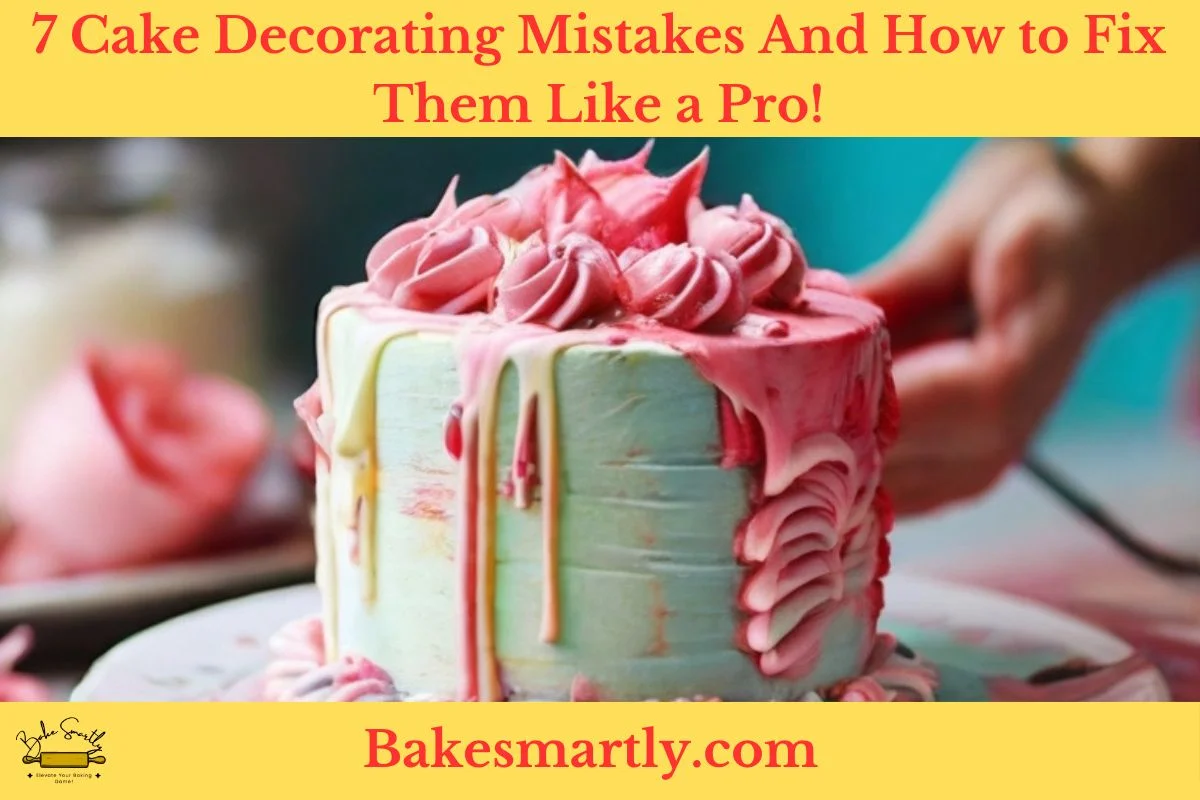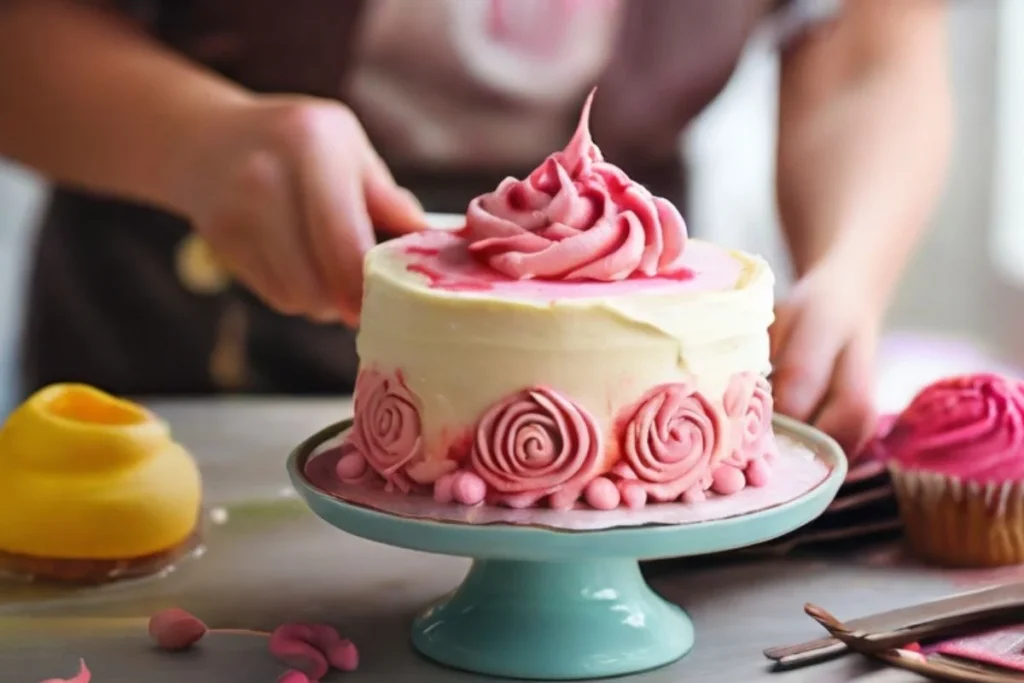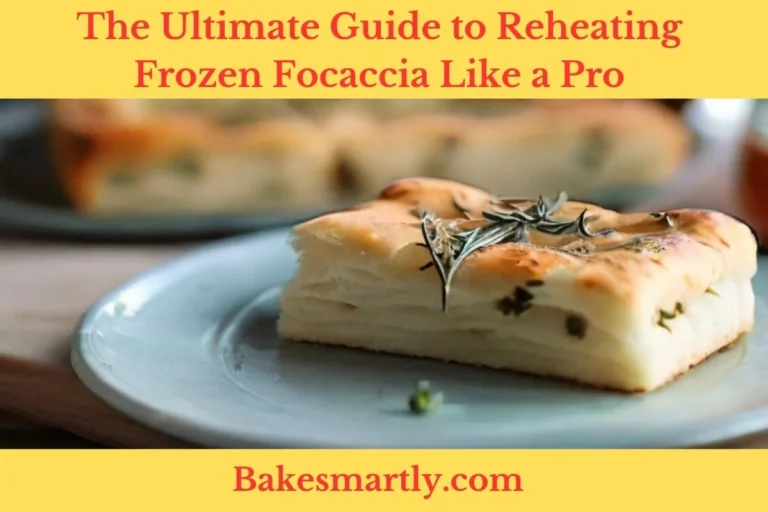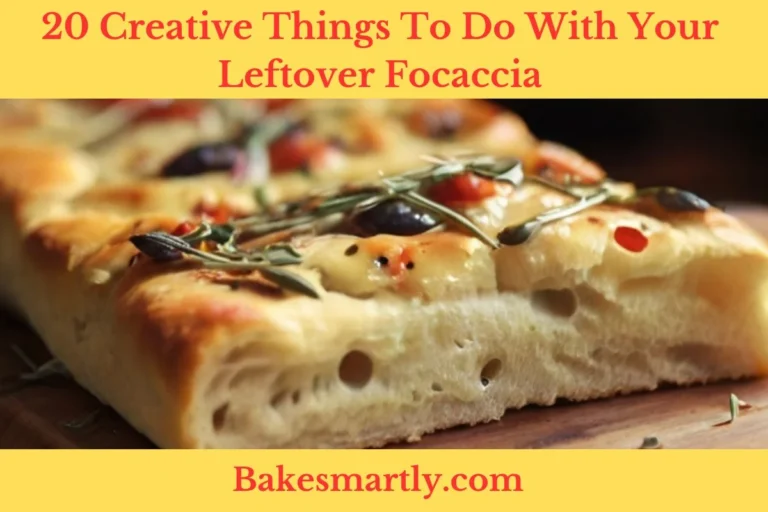
7 Cake Decorating Mistakes And How to Fix Them Like a Pro!
Tired of feeling bummed out when your cake decorating doesn’t go as planned? Whether it’s a funky frosting job, a messy piping design, or layers that just won’t cooperate, baking blunders can be a real downer.
But don’t worry, because we’ve got you covered. In this blog post, we will explore seven common cake-decorating mistakes and how to fix them like a pro.
Additionally, we will share the 8 most common mistakes for beginners and provide tips on how to avoid them.
By the time you finish reading, you’ll have the confidence and skills to tackle any cake-decorating hiccup that comes your way. Get ready to wow your friends and family with your expert cake-saving moves!
Table of Contents
Toggle8 Common Cake Decorating Mistakes for Beginners and How to Avoid Them
Cake decorating is like an art form that lets bakers show off their creativity and transform a basic dessert into a masterpiece. However, it’s not uncommon for beginners to make some common mistakes that can impact the overall appearance and taste of their creations.
In this section, we’ll explore eight common cake-decorating mistakes for beginners and provide helpful tips on how to avoid them.
Not Planning Enough
One of the big cake-decorating no-nos is diving in without a plan. Before you start jazzing up your cake, it’s super important to have a clear picture of the design, colors, and theme.
Skipping this step can lead to a messy and unappealing result. Take a moment to sketch out your design, pick your colors, and gather all your tools and decorations before you kick things off.
Funky Frosting Thickness
Getting a nice, even layer of frosting is key for a cake that looks as good as it tastes. Uneven frosting messes with both the appearance and texture of the cake.
To avoid this, start with a crumb coat – a thin layer of frosting to lock in those cake crumbs. Once that’s set, lay on a thicker layer of frosting evenly with a spatula or scraper. Be patient and take your time for that flawless finish.
Going Overboard with Decorations
Decorations can give a cake character, but too many can make it look like a hot mess. Find a balance between creativity and simplicity. Pick a focal point or theme and choose decorations that go with it.
A well-balanced design not only looks good but also amps up the overall taste of the cake.
Ignoring Room Temperature
When working with fondant and buttercream, the room’s temperature matters. Fondant can get too soft and sticky in warmth, making it tricky to work with.
On the flip side, buttercream can get too stiff in the cold, making spreading a challenge. Make sure your workspace is at the right temperature for the frosting you’re using to get the best results.
Not Keeping Piping Consistent
Consistency is key when you’re piping. Uneven pressure on the piping bag leads to wonky lines and shapes. Practice keeping a steady hand to get uniform decorations.
Try different tips and practice on parchment paper before moving to the real deal. Consistent piping not only makes things look good but also shows off your skills as a decorator.
Forgetting the Power of Color
Color is a big deal in cake decorating, and picking the right palette can make or break your design. Common mistakes include using too many clashing colors or ones that just don’t go together.
Before you dive in, think about the occasion’s theme, the person you’re making it for, and any color trends. Use a color wheel to guide you in creating combos that look good together.
Hustling the Drying Process
Whether you’re working with fondant, royal icing, or glaze, giving things enough time to dry is a must. Rushing it can lead to smudged or messed-up decorations.
Be patient and stick to the recommended drying times for each type of frosting or icing. If you’re in a hurry, consider using a fan or putting the cake in a cool, dry spot to speed up drying without messing up the final result.
Overlooking Texture and Dimension
Adding texture and dimension to your cake decorations can take the design to the next level. Skipping these steps can leave your cake looking flat and blah.
Experiment with different techniques like piping, stenciling, or using edible embellishments to create depth and visual interest. Adding texture and dimension not only makes things look better but also gives a more dynamic and exciting experience for anyone enjoying the cake.

The Importance of Fixing Cake Decorating Mistakes
Fixing mistakes in cake decorating is crucial to making sure your baked creations turn out great. Handling errors promptly doesn’t just make the cake look better, but it also adds to the overall enjoyment of the eating experience.
- First off, correcting mistakes helps maintain the planned design and theme, ensuring the cake serves its decorative purpose well. Whether it’s uneven frosting, color mismatches, or decorations in the wrong place, taking the time to fix these problems ensures the final product matches your creative vision.
- Additionally, fixing mistakes adds a professional touch to your work. Paying attention to details and striving for perfection demonstrate your commitment to the craft, earning respect from those who appreciate the artistry of cake decorating. A well-done cake not only pleases the eyes but also raises the perceived quality of the entire culinary creation.
- Lastly, addressing mistakes can save the taste and texture of the cake. Uneven frosting or poorly applied fondant can affect the eating experience. Dealing with these issues ensures the cake not only looks amazing but also delights the taste buds, leaving a positive and lasting impression on those lucky enough to enjoy it.
How To Fix Cake Decorating Mistakes in Easy Ways
Even experienced bakers run into decorating problems now and then. The good news is that many cake-decorating mistakes can be fixed easily with a bit of creativity and some useful techniques.
In this section, we’ll go over the seven common decorating mistakes and how to easily fix them.

1. Fixing Uneven Icing
One common cake decorating issue is uneven or rough icing. To fix this, try the “Viva Paper Towel Smoothing” technique. Take a piece of Viva paper towel and gently press it against the uneven icing, smoothing it out with your hands.
Viva paper towels, with their minimal pattern, create a polished finish. Alternatively, use an offset spatula dipped in hot water to smooth out imperfections, leaving behind a flawless surface for the next decorating step.
2. Dealing with Color Mistakes
Choosing the right color for your icing is important, but sometimes things go awry. If you end up with the wrong color, don’t worry. To lighten dark icing, add a bit of white icing until you achieve the desired shade.
If your icing is too light, gradually mix in small amounts of your chosen color until you get the perfect hue. Remember, patience is key – make adjustments slowly to avoid going too far.
3. Fixing Fondant Challenges
Working with fondant opens up many decorating possibilities, but it can pose challenges. If your fondant has torn or developed air bubbles, there’s an easy fix.
Knead the torn edges together with a bit of water, smoothing out the seam with your fingers. For air bubbles, use a pin to prick a tiny hole in the fondant, then press out the air and smooth the surface.

4. Repairing Cracked or Broken Cake Layers
A cracked or broken cake layer can be disheartening, but it’s salvageable. To fix a cracked layer, mix a small amount of frosting with some cake crumbs to create a paste. Apply the paste to the cracked area, pressing the pieces together.
Once the paste dries, it acts as a glue, holding the cake together. For a broken layer, gently reassemble the pieces and use the frosting paste as a binder. Once the frosting sets, it will secure the layers, and your cake will be back on track.
5. Fixing Misaligned or Uneven Piping
Piping intricate designs on a cake require precision, and mistakes in alignment or uneven patterns can be frustrating. To fix misaligned piping, use a small spatula to gently lift off the misplaced decoration and reposition it.
If dealing with uneven piping, strategically add extra details or decorations to balance out the design. Turn the mistake into a creative opportunity, transforming the flaw into a unique feature.
6. Reshaping and Resizing Fondant Figures
Creating fondant figures adds a charming touch to cakes, but shaping them perfectly can be challenging. If you’re unhappy with the size or shape of a fondant figure, don’t worry – you can make adjustments.
Soften the fondant with your hands or a bit of water, then reshape or resize the figure as needed. Take your time, and soon you’ll have a perfectly sculpted fondant decoration that complements your cake design.
7. Eliminating Smudges and Fingerprints
Fingerprints and smudges are common issues when working with fondant or delicate decorations. Dip a clean brush in a small amount of cornstarch or powdered sugar to eliminate these imperfections and gently brush over the affected area.
The powders absorb excess moisture, reducing stickiness and leaving your fondant or decorations looking flawless.

Cake Decorating Tips for Beginners
Cake decorating can seem intimidating, but it’s a skill anyone can learn with a little practice and the right tips. Here are 7 beginner-friendly cake-decorating tips to help you create beautiful and delicious masterpieces:
- 1. Start with a crumb coat. Before you go all out with the fancy designs, apply a thin layer of frosting, called a crumb coat, to seal in any crumbs. This will prevent them from showing up in your final design and give you a smooth canvas to work on.
- 2. Use the right tools. You don’t need every tool in the bakery, but a few essentials will make your life a lot easier. Invest in a good offset spatula, piping bags and tips in different shapes, and a cake turntable (optional, but highly recommended!).
- 3. Master the art of piping. Piping is a versatile technique that can be used to create borders, flowers, swirls, and other designs. Start with a simple tip like a round tip and practice making basic shapes like dots and lines. Once you’re comfortable, you can graduate to more intricate designs.
- 4. Keep it simple. Don’t try to create a masterpiece on your first try. Start with a simple design like a few swirls of frosting or a sprinkle of chopped nuts. As you gain confidence, you can add more elements to your decorations.
- 5. Practice makes perfect. The more you decorate, the better you’ll become. Don’t be afraid to experiment and make mistakes. Just remember, every mistake is an opportunity to learn and improve.
- 6. Get inspired. There are endless cake-decorating ideas online and in magazines. Browse some photos find a design that you like and try to recreate it. You can also adapt your favorite cake into a decorated masterpiece.
- 7. Have fun! Cake decorating should be enjoyable, not stressful. So relax, have fun, and let your creativity flow.
Conclusion
Decorating cakes is a fun and rewarding skill that gets better with practice and a willingness to learn from mistakes. Tackle these typical cake decorating issues directly and use the expert tips given.
You’ll soon be on the path to making amazing, pro-looking cakes for any occasion. Embrace your creative side, have a blast with your designs, and relish the sweet satisfaction of showing off a beautifully decorated cake to your happy friends and family.
Have a great time decorating!
Lindsey Mackenzie
About me
Hi there! I’m Lindsey Mackenzie, the founder of Bake Smartly. Baking has been my passion since childhood, growing up in my father’s bakery. With Bake Smartly, I’m excited to share my love for all things sweet and savory. Join me on this delicious journey as we whip up scrumptious treats and sprinkle joy into every bite!






